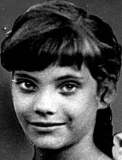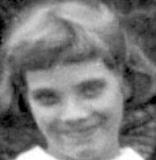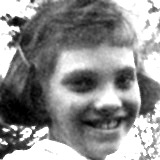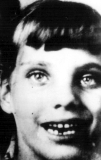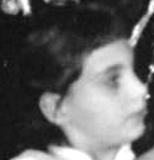Beverly Rose Potts
Beverly, circa 1951
- Missing Since 08/24/1951
- Missing From Cleveland, Ohio
- Classification Non-Family Abduction
- Sex Female
- Race White
- Date of Birth 04/15/1941 (84)
- Age 10 years old
- Height and Weight 4'11, 90 pounds
- Clothing/Jewelry Description Size 14 or 16 girls' blue denim jeans with a side zipper and no label, bright red cotton panties with no tag and with elastic around the waist but not around the leg holes, green socks, a white cotton Honeylane undershirt with a tag, a reddish-pink turtleneck jersey with no label, a navy blue poplin jacket with no label and both pockets torn, size 5 or 5 1/2 brown Karrybrooke Sportshoes loafers which had been re-soled and -heeled, two metal hair clasps with brown plastic covers, and a yellow gold ring. The ring is similar to a wedding ring and has spaces for seven or eight small stones, but the stones are all missing.
- Distinguishing Characteristics Caucasian female. Blonde hair, blue eyes. Beverly had her hair cut in a short bob with bangs shortly before her disappearance. She has wide-set eyes and gaps between her teeth, and her upper and lower molars have silver fillings. She has a vaccination scar on her upper left arm, a small scar over her left eyebrow, and a kidney-shaped birthmark about one inch long and three-eighths of an inch wide on her instep. Beverly had a distinctive, duck-like gait in 1951, with her toes turned out. She was tall for her age at the time of her disappearance and could have easily passed for twelve. She may have grown tall in adulthood.
Details of Disappearance
Beverly left her residence in the 11300 block of Linnet Avenue in Cleveland, Ohio, in the evening hours on August 24, 1951. She and a female friend rode their bicycles to attend the Showagon, an annual summer festival.
The Showagon took place in Halloran Park, which stretches south for three blocks between west 117th and west 120th streets, about an eighth of a mile away from Beverly's home. The area around Halloran Park in 1951 had a number of large trees which obscured the streetlights and made the street almost completely dark after sunset, and vagrants sometimes frequented the park at night.
Beverly had been forbidden to go to the park because she had home from there late a few days before, but her mother gave her special permission to attend the Showagon. Beverly and her friend arrived at the park shortly after 7:00 p.m., but came home again and left their bicycles. They then went back to the park, arriving at the carnival the second time at 8:00 p.m.
Beverly had been given permission to stay until the show was over, but her friend had to be home by dark, and so left at 8:40 p.m. She stated that she last saw Beverly watching the show, standing in front of a small plump woman who had a hand on Beverly's shoulder. The woman may have had a child who was performing in the Showagon.
The last confirmed sighting of Beverly was at 9:30 p.m., when the Showagon had ended and Halloran Park was emptying. A thirteen-year-old acquaintance saw a girl he believed to be Beverly walking diagonally across the park, headed in a northeast direction towards her home. He recognized her by her unusual gait.
She was about 150 feet from the corner of Linnet and west 117th Streets when she was last seen. Her parents reported her missing at 10:30 p.m. when she had not come home and their search of the area failed to turn up any sign of her.
Beverly is not believed to have left of her own accord. She is described as a shy, quiet, obedient girl and a good student who was due to enter the fifth grade at Louis Agassiz Elementary School in the fall of 1951. Beverly had a happy, stable family life at the time of her disappearance. She was also unusually cautious, particularly around men and boys, and would flee when approached by a stranger. She had been warned against unknown men but not against women, so it is possible that she was enticed by a woman.
There have been many false leads in Beverly's disappearance and several possible suspects. Two months after her disappearance a man called her family and demanded $25,000 ransom for her return, but he turned out to be an opportunist who had nothing to do with the presumed abduction. Another man confessed to hitting Beverly with his car on the night she vanished, but his story was also proven to be untrue.
In 1980, a retired Cleveland police detective claimed he had solved the case in 1974. He says he got a letter from the brother of a man who had fled the Cleveland area in 1966 after being charged with the abduction of two girls. The author of the letter stated that his brother had confessed to kidnapping Beverly. When investigators interviewed the brother, he confessed the crime to them, but the district attorney refused to prosecute him for lack of evidence. This story has not been confirmed by official sources.
Another suspect is William Henry Redmond, a carnival worker who died in 1992. He had a long record for child molestation beginning when he was only thirteen, and had been awaiting trial for the 1951 murder of an eight-year-old girl, Jane Marie Althoff, when he died. He allegedly told a cellmate that he had killed three other girls as well as Althoff.
Redmond has never been tied to Beverly's apparent abduction, however, and she is several years older than his other suspected victims. At the time authorities questioned him about the Beverly case in 1988, he refused to make any statement one way or the other about her disappearance. Redmond did pass a polygraph in connection with the unsolved 1952 disappearance of Connie Smith from Connecticut.
In 1994, a letter was discovered under the carpet of a house on Midvale Avenue on the west side of Cleveland. The letter was written in 1960 by a woman who claimed she had caught her husband disposing of Beverly's body in their furnace. Using real estate records, police identified and tracked down the writer, who was eighty-three years old by 1994. Her husband was dead. The woman admitted to writing the letter but said the story was untrue; she wrote it as a fantasy revenge against her husband because he abused her.
In 2000, an unidentified individual wrote two letters to a Cleveland Plain Dealer reporter. The writer stated that he was dying, and confessed to molesting and murdering Beverly on the night she vanished. The letter's author promised to turn himself in to the police on August 24, 2001, the fiftieth anniversary of the Beverly's disappearance, but shortly before this date he sent a third letter to the Cleveland Plain Dealer saying he had to go to a nursing home and thus could not keep his promise to reveal his identity.
Authorities launched an extensive investigation to identify the author of the letters, but they were never able to ascertain anything beyond that the letters were all written by the same person and that their author was probably an elderly, infirm man. Many investigators believe that the correspondence was genuine.
In spite of a very thorough investigation and many leads from the public, investigators never found any trace of Beverly. Police believe she was abducted and murdered, probably by someone she knew and trusted, since she had such a shy nature and a fear of strangers.
Beverly's mother died in 1956 and her father in 1970. Her older sister continued to search for her until her own death in 2006. Beverly remains missing and foul play is suspected in her disappearance.
Investigating Agency
- Cleveland Police Department 216-621-1234
Updated 5 times since October 12, 2004. Last updated February 23, 2018; two pictures added.
